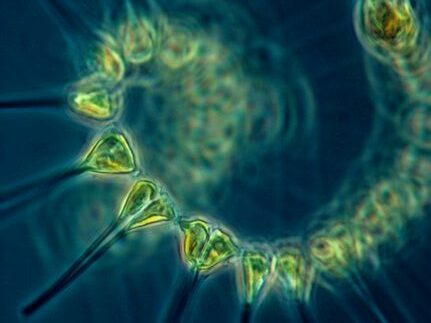

70 % of Earth is water
Only 1% is safe to drink
Our oceans can absorb much more heat than land. About 90% of current global warming is absorbed by our oceans. The ocean’s influence is far-reaching, as it absorbs around 30% of CO2 emissions made by humans. Additionally, marine life contributes significantly to Earth’s oxygen content, with approximately half of all the oxygen present in our atmosphere originating from oceanic organisms.
The ocean plays a vital role in cleaning the air and maintaining the Earth’s atmospheric balance. Through a process known as air-sea exchange, the ocean absorbs various gases, including carbon dioxide, from the atmosphere. Microscopic marine plants like phytoplankton, contribute by absorbing carbon dioxide during photosynthesis. This natural interaction between the ocean and the atmosphere helps regulate air quality and supports the overall health of our planet.
When water becomes heated, it generally retains that warmth for an extended period, cooling down more gradually than land. As water temperature aligns with land temperature, a brief spike in global temperature is possible. Prior to this, the ocean had tempered global temperature calculations. The consistent yearly global warming increase might encounter a distinct upsurge. This shift signifies the point where the ocean’s cooling impact transitions into a contributor to rising global temperatures.
Outcomes of Water Warming
One outcome of warmer water is that there’s less oxygen in the water. Another big issue is that the pH levels in the water change. In some cold parts of the ocean, the salt levels increase, while in most places, the pH levels decrease, making the water less salty, containing less carbon, and becoming more acidic. This change happens too quickly for ecosystems to adjust. In extreme situations, this process of warming water can cause the water to become smelly, unhealthy, and toxic because of an overgrowth of bacteria and algae.
Nutrient pollution
Nutrient pollution, also known as eutrophication, occurs when excess nutrients like nitrogen and phosphorus enter aquatic environments, often from sources such as agricultural runoff, sewage, and fertilizers. These nutrients can stimulate the rapid growth of algae, resulting in algal blooms. As these algae die and decompose, bacteria consume oxygen during the process, leading to oxygen depletion in the water, which can harm aquatic life.
Acidification
Ocean acidification occurs when carbon dioxide (CO2) from the atmosphere dissolves in water, forming carbonic acid. Acidic conditions can have harmful effects on marine life, particularly organisms that rely on calcium carbonate to build shells or skeletons, like corals and some shellfish. Ocean acidification is primarily driven by the increase in atmospheric CO2 levels due to human activities, such as burning fossil fuels.
hypoxia
Water movement, or the lack thereof, can contribute to oxygen depletion. In stagnant or slow-moving water bodies, there is less mixing of oxygen-rich surface water with deeper water layers, which can lead to stratification and reduced oxygen levels in the deeper layers.
Hypoxia often results from nutrient pollution, specifically nitrogen, and phosphorus, entering water bodies. These excess nutrients can lead to the growth of algae, resulting in algal blooms. When these algae die and decompose, bacteria consume oxygen during the decomposition process, leading to decreased oxygen levels in the water. This depletion of oxygen can create hypoxic conditions, often referred to as "dead zones," where aquatic life struggles to survive.
Release of gasses
As water temperature increases, the kinetic energy of water molecules also increases, causing them to move more vigorously. This increased movement disrupts the interactions between water molecules and gas molecules, making it more difficult for gases to dissolve in the water.
Sea level rise
As global temperatures rise, the warming effect extends to the world's oceans, causing them to absorb more heat. As ice sheets in Antarctica and Greenland melt, they release vast amounts of freshwater into the oceans, causing them to expand. The combination of thermal expansion and ice melt contributes to a slow rise in sea levels, posing risks to coastal communities, habitats, and ecosystems.
Less water that is safe to drink
Warmer temperatures can result in water containing harmful viruses and microbes. The decline of fish and plants can lead to further water pollution. Blue-green algae have the potential to produce toxins in the water that are harmful to animals and humans. This can become a concern for our available drinking water reservoirs.
Release of gases
Oxygen (O2): Warmer water holds less dissolved oxygen than colder water. This means that as the water temperature rises, its ability to retain oxygen decreases, potentially leading to oxygen-poor conditions, a condition known as hypoxia.
Carbon Dioxide (CO2): Warmer water can influence the solubility of CO2, impacting the absorbing power of our oceans to reduce our carbon footprint. Dissolved Organic Carbon (DOC) can be broken down by microorganisms that consume the DOC and release carbon dioxide as a byproduct.
Methane (CH4): Dissolved Organic Carbon (DOC) in certain low-oxygen environments, such as sediments at the bottom of lakes, rivers, or wetlands, produces methane. Microorganisms produce methane as a metabolic byproduct during the decomposition of organic matter. Under these conditions, the organic carbon in DOC can be converted into methane, which can then be released into the atmosphere.
Water Vapor (H2O): Warmer temperatures leads to increased evaporation, resulting in higher levels of water vapor in the atmosphere. Water vapor is a natural greenhouse gas that plays a significant role in regulating Earth’s temperature.

Water Warming creates Acidity
Water (H2O) consists of two hydrogen atoms and one oxygen atom. However, warmer water has a reduced capacity to hold oxygen. This warming process, caused by global warming, leads to the release of oxygen from rivers and oceans into the atmosphere.
The decrease in oxygen within the water is referred to as hypoxia. This state creates an excess of nutrients like nitrogen and phosphorus. The result is a lower pH level, higher acidity, and the environment for organisms that generate CO2. Such conditions not only endanger aquatic life but also foster the potential for the emergence of toxins.
Ocean acidification occurs due to the ocean’s capacity to absorb gases from the atmosphere, which includes approximately 30% of the rapidly emitted carbon dioxide (CO2). This influx of CO2 causes a shift in the ocean’s pH level towards more acidic conditions. Marine organisms require a specific pH range in the ocean to form their skeletons and develop shells. Within the scientific community, this phenomenon is often referred to as “ocean osteoporosis.”
Challenges in Ensuring Drinking Water
While only 1% of Earth’s water is suitable for drinking. As water becomes warmer and shifts towards higher acidity levels, maintaining a safe drinking water supply becomes more complex. This transformation also welcomes harmful bacteria and viruses, such as meningitis, which thrive in warmer waters. The evolving water conditions can lead to the demise of numerous plants and fish. This degradation contributes to water toxicity. Interestingly, addressing toxic water often requires the intervention of man-made chemicals. Paradoxically, the solution to toxic water involves substances we introduce ourselves. However, alternative strategies also exist.
pH levels
ACID: 0-7 pH (lemon 2pH)
NEUTRAL: 7 pH (drinking water 7 pH)
BASE0: 7-14 pH (seawater 8 pH)


90% of marine life is at the Sea Surface
Approximately 90% of marine life thrives within the sea’s uppermost layers, known as the sea surface, encompassing depths of 0 to 200 meters. This vital zone is illuminated by sunlight, nurturing photosynthesis, a process that generates oxygen through the activity of plankton, algae, and seaweed. However, it is also this sea surface that absorbs the most global warming and air pollution.
Warming and its Consequences
The accumulation of excessive CO2 within the ocean leads to heightened acidity at the sea surface. This escalation poses challenges to the ocean’s capacity to maintain its air-cleansing function. Simultaneously, heighten water acidity and warmer water temperatures, lead to the release of carbon from both seas and rivers.
A Dire Warning
An array of marine organisms, including corals, shell-bearing creatures, and skeletons, relies on an optimal pH level akin to chalk for their formation. Numerous vital species are intertwined with carbon-dependent marine life, rendering them keystone species within the ecosystem. The acidification of the sea surface jeopardizes these delicate balances, imperiling sea life.
The warming of oceanic waters triggers shifts in the currents coursing through the oceans. These currents are intimately linked with a significant portion of marine life, contributing to their vitality and sustenance. The repercussions of warming oceans reverberate beyond the maritime realm. They impact atmospheric currents, with in turn can disrupt weather patterns. The misconception that marine struggles remain isolated from terrestrial consequences is misguided.
Persisting in the path of global warming could trigger unprecedented upheaval. The delicate balance of marine and terrestrial ecosystems may unravel, potentially resulting in extinction events for both aquatic and terrestrial life forms. This underscores the urgency of addressing climate change to safeguard the intricate tapestry of life that spans our planet’s oceans and lands.


Blue Green Algae
Shapers of Our Skies
Meet “the creators of our sky“, the cyanobacteria, a vast family with around 2000 recognized members. These ancient organisms are likely Earth’s earliest inhabitants, thriving through photosynthesis to generate oxygen, a process that led to the very air we breathe. Some strains are versatile, living beyond water bodies, clinging to trees or rocks.
These bacteria act like algae, often exhibiting a distinctive blue-green or red-brown hue, resembling an oil or paint slick across the water’s surface. They flourish in both freshwater and salty environments, and their presence, in moderation, is only beneficial.
Harmful algal bloom (HAB)
However, when conditions favor their proliferation, these bacteria can take a darker turn. They can transform water into a toxic brew, leaving behind a foul odor and even causing mass fish deaths. The blue-green algae’s prevalence has expanded globally, a phenomenon linked to climate change. Scientists have coined the term “harmful algal bloom” (HAB) to describe their excessive growth.
HAB suppresses biodiversity, triggering a collapse in the ecosystem. This disruption reverberates through the food chain, posing challenges for all life dependent on these delicate interconnections. Reduced sunlight penetrates the water, jeopardizing plants that rely on photosynthesis. The death of these plants contributes to the release of CO2 and methane.
HABs tend to occur under following conditions:
- Stagnant water: allows bacteria to concentrate.
- Nutrient pollution: such as nitrate, nitrogen, and phosphorus
- Warm temperatures: especially during the summer,
HABs tend to release the following gases and toxins:
- Methane: This potent GHG contributes to global warming.
- Neurotoxins: These toxins target the nervous system, creating a range of health issues.
- Hepatotoxins: Affecting the liver, these compounds pose significant health risks.
Health Hazart
Drinking, skin contact, or inhaling fumes from HAB-affected water can lead to severe health issues such as diarrhea, vomiting, eye and skin irritation, headaches, respiratory problems, and immune/allergic reactions.
Ingesting fish carrying HAB toxins can induce sickness. Keep dogs out of water with visible signs of blue-green algae to ensure their safety.


The Uncertain Impact of Water Vapor
Water Vapor and Global Warming:
As the planet warms, water vapor increases, released by heated sea and river surfaces at an annual rate of 1-2%. As the Earth’s temperature rises, oceans and rivers release more water vapor into the atmosphere. This is a natural response to warmer temperatures, as warmer air can hold more moisture. Water vapor is a potent greenhouse gas itself, and its presence creates a positive feedback loop. More water vapor can lead to more warming, amplifying the effects of initial warming.
Water Vapor and Ozone Layer:
The ozone hole, or thinning of the ozone layer over Antarctica, is caused by human-made ozone-depleting substances like chlorofluorocarbons (CFCs). However, warmer temperatures reduce the formation of polar stratospheric clouds, which contribute to the chemical reactions that lead to ozone depletion. So at first glance, warmer temperatures are good for our ozone layer.
Water vapor is generally confined to the troposphere, the lower layer of the atmosphere, and significant amounts rarely reach the stratosphere due to the temperature gradient between these two layers. Water vapor in the stratosphere could potentially contribute to ozone depletion through chemical reactions involving ozone-depleting substances and UV radiation. In the stratosphere, water vapor undergoes molecular breakdown, resulting in molecules with the potential to harm the ozone layer. These molecules not only have the capacity to directly deplete ozone but also engage with ozone-depleting substances (ODS), aiding in their ozone-depleting reactions. While this scenario is complex and highly unlikely, it remains intriguing and deserving of our attention.
The interplay between factors such as water vapor, ozone-depleting substances, and temperature variations can introduce uncertainties into our understanding of ozone depletion. Climate scientists and atmospheric chemists continually study these interactions to improve predictions and understand potential outcomes.
The Uncertanty of Hydrogen
When we examine hydrogen as an energy carrier for cars and transportation, these two significant concerns arise within the scientific community. Hydrogen-powered cars produce water vapor as a byproduct, and the complex water vapor cycle can influence the atmosphere.

Potential danger
- Less water that is safe to drink
- Risk for the extinction of marine life
- Risk of ocean current shifts
- Risk of wind current shifts
- Extreme weather events
- Health hazard from Blue-green-algae
- Increase in water vapor
- Increase in Co2 and methane
- Thinning of the ozone layer
- Warming of the planet
- Turning oceans from mediators into accelerators for climate change
Solutions
Policy makers hold the responsibility to safeguard our drinking water reservoirs and ensure the availability of clean water. It is essential to impose a ban on water sources being subject to stock market trading, preventing water from becoming a speculative investment.
When addressing the challenges of global warming, recognizing the vast predominance of Earth's oceans over its landmass becomes crucial. There appears to be a recurring pattern among world leaders of underestimating our profound reliance on the ocean and the severe impact that climate change exerts on these aquatic ecosystems.
Amidst the current unpredictability, why do we choose to engage in deep-sea mining, dismissing the warnings backed by scientific evidence?
It's imperative that we view our oceans with the same reverence as our land. Just as we've made commitments to safeguard 30% of our land, we must extend this commitment to our invaluable rivers and oceans.
This includes promoting the construction of hydropower dams equipped with mechanisms that facilitate safe fish migration, enabling them to reproduce in oceans. Encouraging local fishers to sell their catch within their communities instead of shipping them to other countries.
Sources and credits
Seeking Equilibrium
Water Warming and Gas Absorption?
As water warms up, it can't hold gases from the air as effectively as cold water. Do you think there's a point at which this reaches a stable balance? Regardless of how warm the water gets, will it always absorb and release the same amount of gases?






